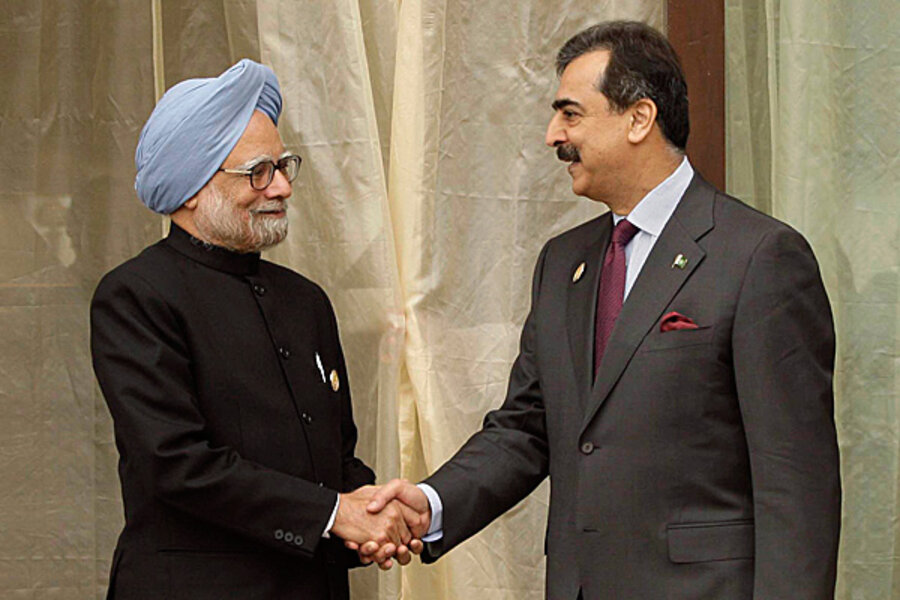India, Pakistan PMs highlight ancestral ties at SAARC meeting
Loading...
| New Delhi
The prime ministers of India and Pakistan met today on the sidelines of the annual meeting of the South Asia Association for Regional Cooperation (SAARC) to talk about restarting a peace dialogue that was hobbled by the Mumbai terror attacks and their aftermath.
In the 75-minute meeting, the two sides agreed to work on arranging more engagements as soon as possible.
SAARC is generally regarded as one of the world's least effective regional bodies. Its stasis is rooted in the bitter rivalry of its two largest members, India and Pakistan, and their moribund peace efforts over the decades.
Yet even talks about talks on the sidelines of a glorified talk-shop have value in this part of the world. In these face-to-face meetings, for a brief moment, the nuclear gamesmanship, proxy warfare in Afghanistan, and cross-border terrorism cannot overshadow recollections of a shared ancestry among the eight nations that make up South Asia – and one-fifth of humanity.
Recalling centuries-old ties, cooperation
Over lunch, Indian Prime Minister Manmohan Singh, a member of the Sikh faith, mentioned to his counterparts that the ancestors of Pakistani Prime Minister Syed Yousuf Raza Gilani, a Sufi Muslim, helped build the Golden Temple. This central Sikh holy site lies in Amritsar, near the present-day border of the two nations formed by the partition of British India in 1947.
"Whereas earlier generations like that of [Singh and Gilani] might take all that for granted, and recall these aspects of our common ancestry with a certain pride and affection, I think maybe younger people may be less aware of all this because they grew up in a different, geographically bounded situation," says Salman Haider, a former foreign secretary of India. "It's good to remind ourselves."
Those reminders of common ancestry, and enduring common interests, rank among SAARC's only achievements to date, says Mr. Haider.
"One of the reasons why SAARC keeps going on is that when [the leaders] meet they realize they have a lot in common and they must not cast aside the possibilities of SAARC," says Haider. "People want it to succeed, but its actual achievements on the ground have not been commensurate with the hopes."
SAARC turns focus to climate change
This year's SAARC meet-up brought the leaders of India, Pakistan, Afghanistan, Bangladesh, Nepal, Sri Lanka, and the Maldives to the mountain kingdom of Bhutan. The conference is focusing on climate change, an issue that is increasingly being led both regionally and internationally by the small states of Bhutan and the Maldives. Both countries view climate change as an existential threat due to receding glaciers and sea level rises.
Coordinating green development and climate adaptation efforts might be the kind of regional issue to energize SAARC, says Haider. Established in 1985, the group has focused on raising trade and development across the region. It mapped out a free-trade zone for the region, known as SAFTA, though tariff reductions are lagging, partly due to distrust between India and Pakistan.
In an interview earlier this month with the Deccan Herald, the head of SAARC denied that tensions between the two rival nations have hampered the regional body.
"It's not true at all. Pakistan and India have been supportive of various SAARC activities, initiatives, and programs," said secretary-general Sheel Kant Sharma. He has also trumpeted SAFTA, saying that trade between the eight nations reached $688 million in 2009.
WTO bigger catalyst for trade – but not mutual respect
However, Haider notes that the World Trade Organization has largely overtaken SAARC as a regional driver for free trade.
But the WTO doesn't exactly provide venues for icebreakers like Singh's respect for Gilani's forefathers. Gilani descends from a line of Qadiri Sufi Muslims. Legend holds that Mian Mir, a Qadiri Sufi based in Lahore, befriended Guru Arjan Dev, the fifth guru of the Sikh faith. Together the two men laid the foundation of the Golden Temple in the 16th century.
"The assumption is that both Guru Arjan Dev and Mian Mir who was a Sufi were catholic enough, tolerant enough, to appreciate each other's position. They respected each other, though they knew the differences," says J.S. Grewal, a historian at the Indian Institute of Advanced Study based in Shimla, India.
Related:





